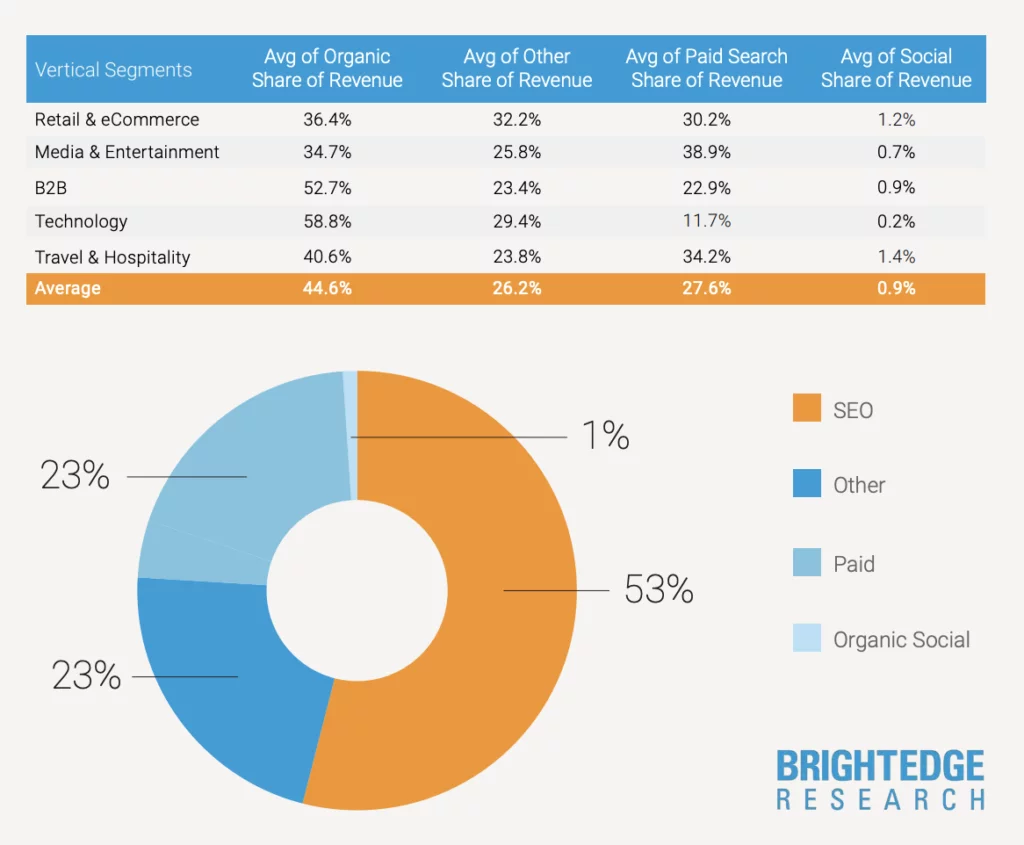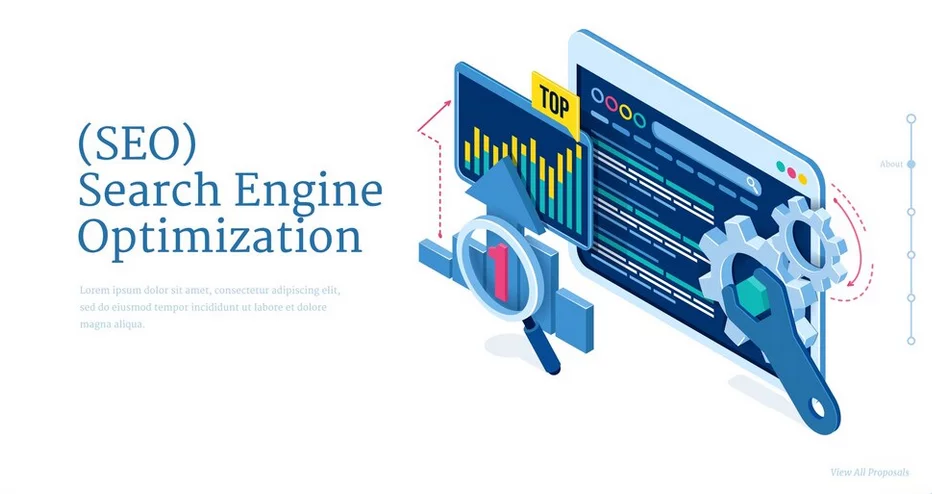Search Engine Optimization (SEO) is a fundamental and indispensable aspect of modern digital marketing. In the ever-evolving digital landscape, SEO’s significance extends beyond just B2C (business-to-consumer) applications; it plays a pivotal role in the B2B (business-to-business) realm as well. For B2B enterprises, SEO presents a distinct set of challenges and opportunities that require specialized strategies. This comprehensive guide is designed to equip you with a deep understanding of B2B SEO, offering invaluable tips and insights to help you refine your B2B SEO strategy.
“In B2B SEO, relevance is the currency that buys you organic visibility.”
– Rand Fishkin
In the digital age, where information is at our fingertips, B2B companies must recognize that their potential clients are also relying on the internet to make informed decisions. Whether it’s sourcing a new vendor, exploring software solutions, or seeking professional services, B2B buyers turn to search engines to initiate their research. This is where B2B SEO becomes a game-changer.

Tips to Optimize B2B SEO:
1. Creating Valuable Content:

In the realm of B2B SEO strategy, content reigns supreme. Crafting high-quality, informative content forms the bedrock of your digital marketing efforts. To excel in this endeavor, utilize industry-specific keywords to drive organic traffic and engage your target audience effectively. Employ the following tools and plugins for enhanced content optimization:
- Google Keyword Planner: Start your content journey by identifying relevant keywords specific to your B2B niche. This Google tool aids in discovering keywords that resonate with your target audience’s search queries.
- SEMrush: For a deeper dive into keyword research and content strategy, SEMrush is a comprehensive tool. It provides insights into your competitors’ content and helps you uncover valuable keywords.

Once you’ve identified the right keywords, focus on crafting content that resonates with your audience’s pain points:
- Blog Posts: Develop well-researched and data-driven blog posts that offer solutions, insights, and thought leadership within your industry. Blogs have become an integral part of content marketing strategies in B2B.
- Whitepapers: Dive into in-depth analysis and research. Create whitepapers that address complex issues, industry trends, and challenges, positioning your brand as an authority.
- Case Studies: Showcase real-world examples of how your products or services have solved problems for your B2B clients. Case studies provide concrete evidence of your value.
Explore IBM’s Think Marketing: IBM’s Think Marketing

IBM’s Think Marketing stands out as a stellar illustration of B2B content excellence. They have mastered the art of delivering valuable insights and solutions to their target audience through in-depth articles on a wide range of B2B topics. By consistently producing high-quality content, they have not only positioned themselves as thought leaders but have also significantly contributed to the industry’s knowledge pool.
2. Enhance Your SEO with On-Page Optimization

Optimizing your website’s on-page elements is a fundamental step toward boosting your online visibility and attracting valuable traffic. It involves refining individual pages to align with search engine best practices and user expectations.
On-Page Optimization Essentials:
- Title Tags: The title of your page is a critical element for search engines and users. It should be concise, relevant, and include your target keywords. For instance, if you’re a B2B software provider, your title tag might be: “Advanced B2B Software Solutions | Company Name.”
- Meta Descriptions: Meta descriptions provide a brief summary of your page’s content. Use them to entice users and include keywords. Make sure the description is engaging and informative, motivating users to click. In the B2B context, a meta description for a software company could read: “Explore our cutting-edge B2B software solutions for enhanced efficiency and productivity.”
- Header Tags: These tags (H1, H2, H3, etc.) structure your content and highlight its hierarchy. The H1 tag should contain the main topic and keyword, while H2 and H3 tags organize subtopics. This structure not only aids search engines but also improves readability for users.
- URL Structure: Create clean and SEO-friendly URLs that include relevant keywords. An example for a B2B software page could be: “yourwebsite.com/b2b-software-solutions.”
Leverage Yoast SEO for WordPress:
For WordPress users, the Yoast SEO plugin simplifies on-page optimization. It offers the following benefits:
- SEO Analysis: Yoast SEO assesses your content’s SEO-friendliness, providing suggestions for improvement.
- Readability Analysis: It evaluates the readability of your content, making sure it’s user-friendly.
- Advanced XML Sitemaps: The plugin generates sitemaps, making it easier for search engines to crawl your site.
- Canonical URLs: Yoast helps you set canonical URLs to avoid duplicate content issues.
- Social Media Integration: Optimize how your content appears on social media platforms.
Real-Life Case: HubSpot

Consider the case of HubSpot, a prominent B2B marketing and sales software provider. HubSpot employs on-page optimization techniques effectively. Their title tags are succinct and keyword-rich, guiding users and search engines. Meta descriptions are persuasive, encouraging clicks and informing users about their content. Header tags are used to structure content and make it easy to digest.
Their URL structure is clean and concise, incorporating essential keywords. By combining these on-page optimization practices with the Yoast SEO plugin, HubSpot maintains a strong online presence in the competitive B2B software sector.
3. Embracing Mobile Responsiveness for B2B Success

In today’s mobile-first era, ensuring your website is mobile-responsive is paramount in the world of B2B.
The Significance of Mobile Responsiveness:
- Changing User Behavior: With an ever-increasing number of users accessing the internet on mobile devices, it’s imperative to adapt. B2B professionals are no exception; they browse and research products and services while on the go.
- SEO Impact: Search engines, including Google, prioritize mobile-friendly websites. Ensuring your site is responsive directly affects your search engine rankings.
- User Experience: A mobile-responsive site offers a seamless and user-friendly experience. It’s more likely to keep visitors engaged and encourage them to explore your B2B offerings.
Tools and Plugins for Mobile Responsiveness:
- Google’s Mobile-Friendly Test: This tool is an excellent starting point. Enter your website’s URL, and it will provide a report on your site’s mobile-friendliness, highlighting areas for improvement.
- Responsive Design Frameworks: Consider utilizing responsive design frameworks like Bootstrap or Foundation. These frameworks streamline the process of building mobile-responsive websites.
- Content Management Systems (CMS): If you’re using a CMS like WordPress, explore responsive themes and plugins that adapt your website for mobile devices. For instance, the WPtouch plugin creates mobile-friendly versions of WordPress websites.
Real-Life Example: Salesforce

A standout example of a B2B company embracing mobile responsiveness is Salesforce. As a leader in customer relationship management (CRM) software, they recognize the importance of mobile accessibility.
- Mobile-Optimized Website: Salesforce’s website is not only mobile-responsive but also optimized for mobile use. The layout and content are designed to fit various screen sizes, ensuring a seamless experience for B2B professionals accessing their site on smartphones and tablets.
- Mobile Applications: Salesforce provides dedicated mobile applications for managing CRM, allowing B2B users to access essential tools and data on the go.
- Mobile-First Approach: Their mobile-first approach ensures that new features and updates are designed with mobile users in mind.
4. Boosting B2B SEO with Effective Backlink Building

Backlinks, also known as inbound links, are links from external websites to your site. They serve as a vote of confidence from other authoritative sites, indicating your content’s credibility. In the B2B sector, they are invaluable for several reasons:
- Improved Authority: Quality backlinks enhance your website’s authority in the eyes of search engines like Google.
- Enhanced Visibility: Backlinks from authoritative B2B websites can boost your search engine rankings, increasing your visibility to potential clients.
- Referral Traffic: Backlinks not only aid in SEO but can also drive relevant traffic directly from the referring site to your B2B website.
Tools and Plugins for Backlink Building:
- Ahrefs: A comprehensive SEO tool that allows you to analyze your backlinks, find opportunities for link building, and conduct competitor research.
- Moz Link Explorer: Moz offers a backlink research tool that helps you discover new link-building opportunities, monitor your progress, and identify potentially toxic links.
- SEMrush: SEMrush provides insights into your competitors’ backlink strategies and helps you identify authoritative websites in your niche.
Effective Backlink Building Strategies:
- Guest Posting: Offer to write high-quality, informative articles for authoritative B2B publications in your industry. In return, you can include backlinks to your own content or website.
- Collaborative Content: Collaborate with industry influencers, experts, or other B2B companies on informative content such as webinars, podcasts, or reports, which can include backlinks to your website.
- Resource Pages: Identify resource pages on authoritative B2B websites and request to have your site or content linked as a valuable resource.
Real-Life Example: Shopify Plus

Shopify Plus, a leading B2B e-commerce platform, has effectively harnessed backlink building in their SEO strategy. By providing valuable insights on e-commerce trends and strategies, they gained backlinks from various authoritative B2B sources. Their articles and reports offer valuable information and statistics to the e-commerce industry, positioning them as an authoritative source.
For instance, their report on the growth of direct-to-consumer (DTC) e-commerce not only provided industry insights but also garnered backlinks from e-commerce publications, strengthening their online presence and search engine rankings.
5. Mastering Keyword Research for B2B SEO Success

Keyword research is the process of identifying and selecting the most relevant and valuable keywords that potential clients are likely to use when searching for products, services, or information related to your B2B niche. It is essential for the following reasons:
- Improved Visibility: By targeting the right keywords, you can enhance your website’s visibility in search engine results, connecting you with your target audience.
- Relevance: Keyword research helps ensure your content aligns with the specific queries and interests of potential clients, thereby driving more qualified traffic.
- Competitive Edge: Identifying valuable keywords allows you to outperform competitors and rank higher in search results.
Tools and Plugins for Keyword Research:
- Ahrefs: A powerful SEO tool that offers a robust keyword research feature, enabling you to discover and analyze keywords relevant to your B2B niche.
- Moz: Moz provides a keyword research tool that helps you identify and evaluate keywords for SEO, as well as track your rankings.
- Google Keyword Planner: Part of Google Ads, this tool offers insights into keyword search volume, competition, and related keywords. It’s a valuable resource for understanding user intent and conducting keyword research.
Effective Keyword Research Strategies:
- Seed Keywords: Start with a set of seed keywords that are directly related to your B2B offerings. These will serve as a foundation for your research.
- Competitor Analysis: Analyze the keywords your competitors are targeting. Tools like Ahrefs can help you identify their top-performing keywords.
- Long-Tail Keywords: Consider long-tail keywords, which are more specific and less competitive. They often lead to higher conversion rates.
- User Intent: Understand the intent behind keywords. Are users looking for information, products, or solutions? Tailor your content accordingly.
Real-Life Example: SAP

A prime example of effective keyword research in the B2B sector is SAP, a global leader in enterprise software solutions. SAP conducts meticulous keyword research to target specific phrases related to their products and services. They have a diverse portfolio of solutions, from ERP to cloud computing, and use keyword research tools like Ahrefs and Google Keyword Planner to:
- Identify keywords relevant to each product and service.
- Determine the search volume for these keywords, allowing them to prioritize high-value terms.
- Optimize their content and website to rank prominently for these keywords in search engine results.
5. Elevating B2B SEO with Technical SEO Optimization

Technical SEO is the backbone of your online presence, focusing on the backend of your website to ensure optimal performance and search engine visibility. To excel in the B2B landscape, consider the following key aspects of technical SEO:
- Site Speed Optimization: Fast-loading websites are favored by search engines and visitors alike. Utilize tools like Google PageSpeed Insights to assess and improve your site’s speed.
- XML Sitemaps: Creating and submitting XML sitemaps to search engines enhances indexability. By offering a structured map of your website’s content, you make it easier for search engines to crawl and understand your site.
7. Social Media Integration: Connecting with Your B2B Audience

In the dynamic world of B2B, social media integration plays a vital role in expanding your reach and fostering engagement. To succeed in this realm, consider these strategies and tools:
- LinkedIn Integration: As a B2B professional platform, LinkedIn is ideal for connecting with your audience. Share valuable content, actively engage, and participate in industry discussions.
- Buffer and Hootsuite: Streamline your social media efforts with management tools like Buffer and Hootsuite. These platforms allow you to schedule posts, monitor engagement, and track performance.
Real-Life Example: IBM’s Social Media Engagement
IBM, a global technology and consulting company, effectively leverages social media integration to connect with their B2B audience. Visit IBM’s LinkedIn Page to witness their active engagement, thought leadership, and valuable content sharing within the B2B community.
8. Boosting B2B SEO with Schema Markup

Schema markup, often referred to as structured data, is a language used by search engines to better understand the content and context of web pages. By implementing schema markup on your B2B website, you gain several advantages:
- Enhanced Visibility: Schema markup can result in rich snippets in search results, making your content stand out and increasing click-through rates.
- Improved Understanding: Search engines can better interpret the content on your website, ensuring it’s displayed to the most relevant audience.
- Featured Snippets: Structured data can lead to featured snippets, providing concise answers to user queries and positioning your site as an authoritative source.
Tools and Plugins for Schema Markup:
- Google’s Structured Data Markup Helper: This free tool assists in creating and implementing structured data for your B2B content. It provides a user-friendly interface for adding markup to your web pages.
- Schema.org: The official website for schema markup offers a comprehensive reference guide and examples for various types of structured data.
- WordPress Plugins: If your B2B website is built on WordPress, plugins like WP SEO Structured Data Schema can simplify schema markup implementation. These plugins are valuable for WordPress users looking to enhance their website’s structured data and improve search engine visibility.
Effective Schema Markup Strategies:
- Identify Relevant Schema Types: Determine which types of structured data are most relevant to your B2B content. This can include product information, articles, events, and more.
- Use Google’s Structured Data Markup Helper: Input your web page URL into Google’s Structured Data Markup Helper and follow the step-by-step guide to add structured data to your content.
- Testing and Validation: After implementing schema markup, use Google’s Structured Data Testing Tool to validate the markup and ensure there are no errors.
Real-Life Example: Cisco

A notable example of effective schema markup in the B2B sector is Cisco, a global technology company. Cisco implements structured data across its website to enhance search engine visibility and improve user experience.
- Product Markup: Cisco employs schema markup to provide detailed information about its wide range of products, including routers, switches, and security solutions. This enables search engines to display rich product information in search results, such as product ratings and prices.
- Event Markup: Cisco often hosts and participates in events. By using structured data for events, they ensure that event details, dates, and locations are presented prominently in search results.
- Article Markup: Cisco’s blog section utilizes schema markup for articles. This enhances the visibility of their blog posts and allows for potential inclusion in featured snippets.
9. Elevating B2B Success with User Experience (UX)

User experience (UX) plays a critical role in B2B SEO and website performance. It is vital for retaining visitors, improving search engine rankings, and shaping your brand’s image. Here’s a detailed look at the significance of UX, tools and plugins to enhance it, and real-world examples:
Understanding the Importance of User Experience:
- Visitor Engagement: A stellar user experience keeps visitors engaged, encourages exploration, and increases conversion rates. A user-friendly website is more likely to convert visitors into customers.
- Search Engine Rankings: Search engines value positive user experiences. Factors like fast load times, mobile-friendliness, and clear navigation all contribute to better SEO rankings.
- Brand Perception: Your website’s design and functionality reflect on your brand. A well-designed, user-friendly site conveys professionalism, trustworthiness, and commitment to quality.
Tools and Plugins for User Experience:
- Hotjar: Hotjar is an all-in-one tool for analyzing user behavior. It offers heatmaps, session recordings, and user surveys to gain insights into user interactions.
- Google PageSpeed Insights: This tool evaluates your website’s speed, an essential aspect of user experience.
- WordPress Plugins: If your B2B website is built on WordPress, consider plugins like WP Fastest Cache or WP Super Cache to enhance site speed and performance.
Effective User Experience Strategies:
- Website Speed: Use tools like Google PageSpeed Insights to assess your site’s speed. Optimize it by compressing images, utilizing browser caching, and minimizing code for faster loading times.
- Mobile-Friendliness: Ensure your website is responsive and functions well on various devices. Test it on different screen sizes and devices to guarantee a smooth mobile experience.
- Clear Navigation: Simplify your website’s navigation, making it intuitive for users to find the information they need. Organize content logically, use clear menus, and ensure easy access to essential sections.
Real-Life Example: Salesforce

Salesforce, a leader in cloud-based customer relationship management (CRM) solutions, is renowned for its exemplary user experience. Their website is optimized for mobile devices, boasts fast load times, and provides intuitive navigation. Whether you’re a potential customer or a long-time user, navigating the website is seamless, reflecting their commitment to user satisfaction.
10. Analytics and Monitoring: Enhancing B2B SEO with Data-Driven Decisions

Analytics and monitoring are vital in B2B SEO. They help track the performance of your SEO strategy, make data-driven decisions, and analyze competitors’ strategies. Let’s delve deeper into the importance of analytics and monitoring:
Analytics and Monitoring Benefits:
- Performance Tracking: Analytics tools help monitor the impact of your SEO efforts, including ranking changes, organic traffic trends, and conversion rates.
- Data-Driven Decisions: With accurate data, you can make informed decisions to refine and enhance your SEO strategy over time.
- Competitive Analysis: Analytics tools allow you to analyze your competitors’ strategies, benchmark your performance against them, and identify new opportunities.
Tools and Plugins for Analytics and Monitoring:
- Google Analytics: A robust tool providing comprehensive insights into website performance, user behavior, and traffic sources.
- Google Search Console: This tool offers data on how Googlebot views your site, including indexing information and search queries that lead to your site.
- SEO Plugins: If your B2B website is on WordPress, plugins like Yoast SEO offer built-in analytics features to track keyword rankings and on-page SEO performance.
Effective Analytics and Monitoring Strategies:
- Tracking Keywords: Monitor keyword rankings over time to identify areas where you’re gaining or losing visibility. Tools like Google Search Console, Ahrefs, or SEMrush can assist with this.
- Traffic Analysis: Use Google Analytics to understand how organic traffic interacts with your website. Analyze user behavior, page views, and conversion rates to fine-tune your content and strategy.
- Conversion Tracking: Set up conversion goals in Google Analytics to track key actions on your site, such as form submissions or product purchases.
Real-Life Example: Moz

Moz, a well-known provider of SEO software and tools, demonstrates the power of analytics and monitoring in B2B SEO. They closely track keyword rankings, organic traffic trends, and conversion rates, enabling data-driven decisions to refine their content and strategy. Moz also offers a range of resources and tools to help other businesses succeed in the ever-evolving world of SEO.
Conclusion:
In the world of B2B marketing, SEO is a dynamic and ever-evolving discipline. Implementing the right strategies and staying up-to-date with the latest trends is crucial for success. By focusing on high-quality content, technical optimization, and a deep understanding of your target audience, you can make significant improvements in your B2B SEO efforts. Consistency and patience are key, as SEO results often take time to manifest. With dedication and a well-thought-out strategy, your B2B business can achieve improved visibility and generate more valuable leads from search engines.
FAQs on B2B SEO Tips
What are the key differences between B2B and B2C SEO?
B2B SEO often targets niche keywords, focuses on longer sales cycles, and may involve more technical and industry-specific content. B2C SEO, on the other hand, typically targets broader keywords, shorter sales cycles, and a more diverse consumer audience.
How can I optimize my website’s technical SEO for B2B purposes?
Technical SEO for B2B includes improving site speed, ensuring mobile-friendliness, optimizing site structure, and focusing on user experience. It’s crucial to fix technical issues, ensure proper indexing, and implement schema markup for structured data.
Should I invest in link building for B2B SEO?
Yes, link building is vital for B2B SEO. High-quality, relevant backlinks from reputable sources can improve your website’s authority and search engine rankings. Building relationships with industry influencers and publishing guest posts can be effective link-building strategies.
How do I measure the success of my B2B SEO efforts?
Success can be measured through various key performance indicators (KPIs) such as organic traffic, keyword rankings, lead generation, conversion rates, and return on investment (ROI). Regularly monitoring and analyzing these metrics is essential for tracking progress.
Is B2B SEO a long-term strategy?
Yes, B2B SEO is a long-term strategy. It takes time to see substantial results, and continuous efforts are necessary to maintain and improve your search engine rankings. It’s an ongoing process that requires commitment.



